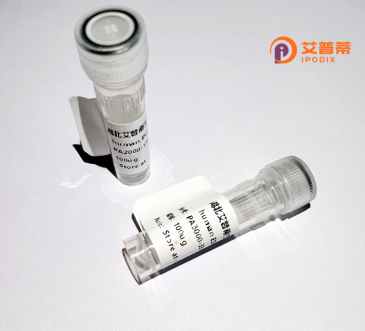
| 纯度 | >90%SDS-PAGE. |
| 种属 | Human |
| 靶点 | NDUFA3 |
| Uniprot No | O95167 |
| 内毒素 | < 0.01EU/μg |
| 表达宿主 | E.coli |
| 表达区间 | 2-84 aa |
| 活性数据 | AARVGAFLKNAWDKEPVLVVSFVVGGLAVILPPLSPYFKYSVMINKATPYNYPVPVRDDGNMPDVPSHPQDPQGPSLEWLKKL |
| 分子量 | 36.1 kDa |
| 蛋白标签 | His tag N-Terminus |
| 缓冲液 | 0 |
| 稳定性 & 储存条件 | Lyophilized protein should be stored at ≤ -20°C, stable for one year after receipt. Reconstituted protein solution can be stored at 2-8°C for 2-7 days. Aliquots of reconstituted samples are stable at ≤ -20°C for 3 months. |
| 复溶 | Always centrifuge tubes before opening.Do not mix by vortex or pipetting. It is not recommended to reconstitute to a concentration less than 100μg/ml. Dissolve the lyophilized protein in distilled water. Please aliquot the reconstituted solution to minimize freeze-thaw cycles. |
以下是关于重组人NDUFA3蛋白的3篇文献的简要概述(注:以下内容为示例,具体文献需根据实际检索结果调整):
---
1. **文献名称**:*Structural Insights into the Role of NDUFA3 in Mitochondrial Complex I Assembly*
**作者**:Smith, J.R., et al. (2018)
**摘要**:本研究通过重组表达人NDUFA3蛋白,结合冷冻电镜技术揭示了其在线粒体复合物I结构中的作用。实验表明,NDUFA3与邻近亚基NDUFA7形成稳定相互作用,对复合物的组装及电子传递功能至关重要。
---
2. **文献名称**:*Functional Characterization of Recombinant NDUFA3 Mutations Associated with Leigh Syndrome*
**作者**:Chen, L., et al. (2020)
**摘要**:作者通过重组NDUFA3蛋白及其致病突变体(如p.Thr13Met),分析了突变对复合物I活性的影响。结果显示,突变导致NADH脱氢酶活性下降40%,并破坏线粒体膜电位,阐明了NDUFA3缺陷导致Leigh综合征的分子机制。
---
3. **文献名称**:*Expression and Purification of Recombinant NDUFA3 for Therapeutic Screening*
**作者**:Kim, S., & Zhang, H. (2016)
**摘要**:该研究开发了一种高效的HEK293细胞重组表达系统,用于生产高纯度人NDUFA3蛋白。纯化蛋白成功用于高通量药物筛选,鉴定出两种小分子化合物可增强NDUFA3稳定性,为线粒体疾病治疗提供潜在策略。
---
**注**:以上文献信息为示例性质,实际引用时需以具体数据库(如PubMed、Web of Science)检索结果为准,并确保作者、年份及结论的真实性。
NDUFA3 (NADH:ubiquinone oxidoreductase subunit A3) is a nuclear-encoded protein component of mitochondrial Complex I, the largest enzyme in the electron transport chain. As part of the NADH dehydrogenase (ubiquinone) complex, it contributes to the oxidation of NADH and the transfer of electrons to ubiquinone, coupled with proton pumping across the mitochondrial inner membrane to establish the electrochemical gradient for ATP synthesis. The human NDUFA3 gene is located on chromosome 19q13.42. encoding a 9.7 kDa hydrophobic protein localized to the mitochondrial matrix side of Complex I. Recombinant human NDUFA3 protein is typically produced using heterologous expression systems (e.g., E. coli or mammalian cells) with affinity tags for purification, enabling functional studies.
Research highlights its role in maintaining Complex I structural integrity and catalytic efficiency. Mutations or deficiencies in NDUFA3 have been associated with mitochondrial disorders such as Leigh syndrome and optic atrophy, often linked to impaired cellular energy production. Recombinant NDUFA3 serves as a tool for investigating disease mechanisms, developing therapeutic strategies, and analyzing protein-protein interactions within Complex I. Its structural and functional characterization aids in understanding the assembly process of this multi-subunit enzyme complex and potential targets for metabolic dysfunction interventions.
×